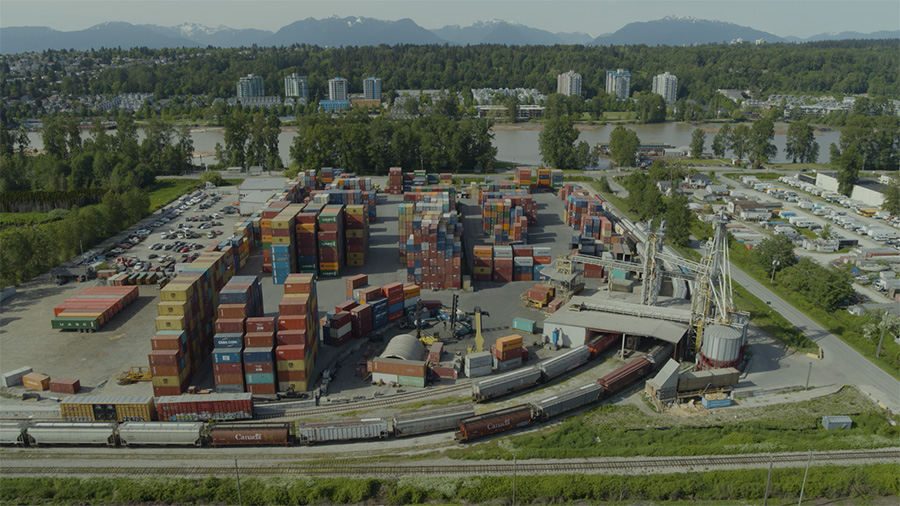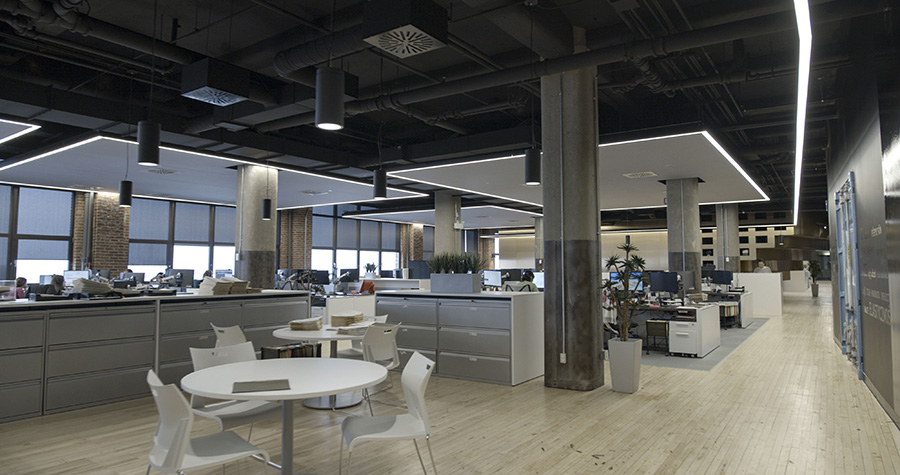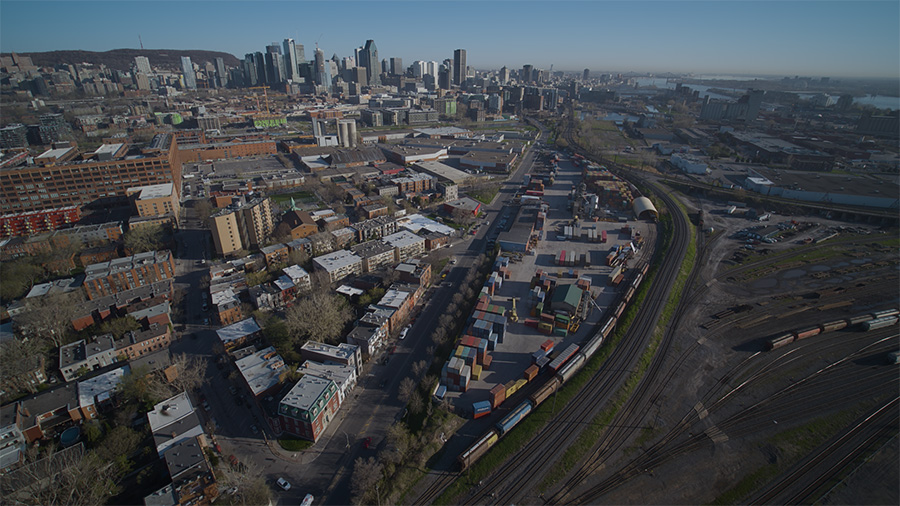June 26, 2020
Ray-Mont’s Vice President of Supply Chain Logistics on how the company has grown and changed hand in hand with Canada’s pulse industry.


For nearly three decades, Ray-Mont Logistics’ history and growth has been intrinsically linked with that of North America’s pulse industry. Founded in 1992 as a trucking outfit, the company was originally dedicated to delivering pulses to a transloading operation in Montreal. Observing his client at work, Ray-Mont’s then owner, Francois Raymond, thought that if he had a transloading business, he would do things differently. In 1994, he decided to put his ideas to work and opened Raymond Containers, the foundation for Ray-Mont Logistics existing transloading divisions.
The transloading of pulses from intermodal and boxcars into containers would drive the company’s growth from the late ’90s to the early 2000s, just as the North American pulse industry was becoming the top pulse supplier on the global stage.
Since then, under the leadership of current Ray-Mont president and CEO Charles Raymond, the company expanded its operations in Montreal (2005) to include multiple transloading services, and opened additional transloading facilities in Vancouver (2008) and Prince Rupert (2017), British Columbia. Moreover, in 2009 it ventured into freight forwarding and in 2019 into domestic logistics, with the aim of integrating its three services – domestic movements, transloading and ocean freight – into one efficient solution for its clients.
In 2012, the company expanded its freight forwarding operations into the U.S. and last year, across its network, it began offering its services for other products besides pulses, including plastic resin and forest products.

Stephen Paul, Ray-Mont’s Vice President of Supply Chain Logistics, indicates the company exported in excess of 100,000 containers in 2019, of which 95% were agricultural products, mainly peas, lentils, chickpeas, dry beans, soybeans and canola, among others.
Ray-Mont has come a long way since its origins as a trucking company, and yet, Stephen says, “our core business and foundation upon which the company was built has been and continues to be pulses.”
For several years now, Ray-Mont has maintained a near constant presence at GPC annual conventions. This year, Stephen served as a panelist in the debut edition of the GPC Ask the Experts webinar series, which examined the impact of COVID-19 on shipping logistics and the global food supply chain.
“We intend to be more and more involved with the GPC,” says Stephen. “We see the GPC as a valuable platform for us to communicate with the pulse industry. The more people from the various points in the supply chain understand the logistics dynamic that takes place throughout a transaction, the more informed and educated conversations we can have. That applies to us at Ray-Mont as well. We are constantly learning about the reality and logistical constraints at various destinations. GPC gives us the platform not only to communicate and engage with different stakeholders, but to also listen and learn. By doing so, we gain insights that allow us to enhance the product we offer our clients and to find solutions.”
In the spirit of just such a dialogue, the GPC reached out to Stephen to get the logistic industry’s perspective on the pulse trade during these challenging times.

Stephen: In all honesty, I stumbled into it. I was 19 at the time and I was looking for a job. I saw a posting for a company whose name I couldn’t even pronounce that was offering a traffic clerk position. I thought it was a valet job. I figured I would be parking cars and I said to myself, hey, I can do that for $10 an hour. You know, at 19 you are just looking to start at a good wage and the type of work you do is not all that important. So, I went over to drop off my resume and when I saw there weren’t any cars in the lot, it became clear this was going to be an office job.
Anyway, I got called in for an interview and got hired. That was the beginning of my career. I started out as a traffic clerk working for Panalpina, a freight forwarder based in Winnipeg.
Stephen: I was an assistant to the export account manager, who worked with clients in the pulse sector. Panalpina was a very big player in freight forwarding pulses in Canada at the time. I was also the youngest person in the office by 11 years and there was a big technology gap between myself and the older employees. So, I had the side task of helping my co-workers with computer software programs and that sort of thing. I had never seen a typewriter until I started working there. They were using typewriters and fax machines, and in high school I was using computers and other electronic devices.
At the same time, although my time was brief, the people I worked with had numerous years of experience and they taught valuable lessons that I still apply to this day.
Stephen: It’s the people in the organization. We stress a lot on core values in what we do and that helps drive our growth.
The job is also about finding solutions. As this industry has evolved, it hasn’t been easy. There are many challenges that have arisen. But the satisfaction of continuing to grow and finding options to make cargo flow effectively and smoothly, that’s a major takeaway of the job for me personally.
Stephen: The biggest challenges are timeliness and fluidity. Pulses come in waves. You have peak and low seasons. In peak season, the challenge is finding how to push through the volume effectively in a concentrated timeframe.
Pulse markets are also quite volatile. Our customers have contractual requirements that they have to execute and moving pulses within North America is particularly challenging because of geography. In Canada and the U.S., most of the pulses are grown inland and there are many supply chain complexities to get them to the ports and loaded onto vessels. It is a challenge to match up all those different connecting parts.
The other aspect of pulses that makes it challenging is that it is a product destined for human consumption. That means you have to be cautious of contamination and food safety requirements. Ray-Mont has taken steps to be ISO food safety certified at all of our facilities because we do not want to blemish the integrity of the production. When we deliver pulses, there is a clear paper trail from origin to destination of what we load inside every container.
And, of course, there is the weather. During the months of December through February, it can be extremely cold in Canada. That slows down the trains and they take reduced capacity. It creates a bottleneck in the supply chain. On top of that, the danger of landslides and avalanches is always there, and that could cut off a railway and create additional pressure in a moment’s notice, because once the rail lines are cleared again, it creates a downhill effect where all that backlog that has built up comes pouring in and we have to execute even more effectively to hit those contract obligations. Especially if the market has dropped, a foreign buyer isn’t going to be willing to grant an extension because of weather. If the market goes up, then they might give you some leeway.
That’s always been the biggest challenge – getting shipments out within specific time parameters.
Stephen: Things were fairly simple 20 years ago. Freight rates were valid for a year. Fuel surcharges weren’t even a component of rates back then. Documentation could be submitted with the shipment on the water and in some cases right up to when it arrived at destination. The regulations were looser with respect to transactions.
Then 9/11 changed everything. There was a big push on security and ensuring that cargo was pre-declared. From that point forward, you saw a big shift towards more regulation and new processes and documentation. Fuel surcharges were introduced, and pricing went from a yearly to a quarterly component, which in most cases is now month to month
And as things evolved, through different events and international growth in the container supply chain, we are seeing new components and tools introduced year after year.
This year, the COVID-19 pandemic has posed even more challenges. It really has brought to light how fast the industry is growing. More and more ocean carriers are now using spot booking tools or asking clients for guarantees or deposits in order to get space on a vessel.
We are seeing a lot of new developments in technology. To that end, our company has a sister company called Nexus Innovations. It is a fully independent IT company that we opened three years ago because we had to adapt to the technological requirements that transloading and freight forwarding present as we continue to grow.
In this era, there is such a great need for information that there is constant requirement to provide transparency and information to our clients, suppliers and partners to make sure that at any given moment they have access to real-time information and knowledge about what is taking place.
Undoubtedly, the biggest change over the years has been on the technology side.
Stephen: When the events of late January and early February took place in China, we began to see the ripple effects of COVID-19. Blank sailings started to be announced and our volume at that particular time were increasing. When you combine increased volumes with reduced vessel capacity, it puts more of a strain on the supply chain to make things work.
As February progressed, the situation in China worsened. The number of blank sailings increased and when those that originated in China hit North America in early March, deliveries to port went from being weekly to being every other week with certain carriers. The supply of empty equipment started to diminish because we were waiting for imports from China to come into North America and piggyback off of that equipment for export.
North America as a whole is import driven. Empty containers typically aren’t repositioned to North America, rather the containers come in with the import trade. So that’s when we really started to feel the impact of COVID-19.
Then in mid-March, when the virus was spreading globally, North America went into lockdown and we started to have to do things differently. Our office staff of 80 employees began to work remotely from home. As a company, we are fairly technologically savvy with respect to what we do, but even so we weren’t prepared to have 80 people working from home full-time. We had to learn how to communicate effectively with each other from afar, how to handle customers, shipments and so forth. It was a tremendous learning curve and we had to keep the business flow as smooth as possible for our customers.
At the transloading facilities, meanwhile, business wasn’t slowing down. As panic set in and people started stocking up their pantries worldwide on dry food, demand for pulses was rising and our customers were pushing us to get product out. We actually had to hire more people because of pandemic-related demand. Interviewing and training new employees for logistics positions and the transloading divisions was a big challenge because, even though we fell into the essential services category which allowed us to continue operating, you still had to convince people to come to work while the government was instructing people to stay home.
It was a real challenge from an HR and operational perspective to keep the wheels of a facility turning with staff on edge and demand increasing. At Ray-Mont we are an integrated company. We work with our customers in up to three layers of the transaction: domestic logistics; freight forwarding and transloading. No one service is independent of the others, and if one fails, the entire supply chain folds
On the flip side, those of us working from home eventually found our groove and it could be said that we actually became more efficient working from home because you can isolate yourself in a bubble and get things done without distractions.
At the terminals we continue to be quite busy. During summer here in North America, our volumes typically decline, but this year they haven’t. We are also seeing a trend of more bagged products to different destinations, particularly in Latin America, as countries there look to stock up more on finished products rather than bulk commodities that are bagged later.
Stephen: No. We actually experienced some of the busiest months in the history of Ray-Mont during the spring. There wasn’t any slow down to a degree. There were some challenges due to the lack of containers and vessel space in parts of March and April that were impacting fluidity, but the overall demand for pulses just kept spiking.
Now with India lifting tariffs on lentils, there is another push to get that cargo to destination before the end of August when those tariffs go back into effect. In addition, Ray-Mont is the designated agent for the World Food Programme in Canada, and we’ve seen our volumes with them increase significantly because of the pandemic. We’ve moved a good number of containers in the past few months and there are more scheduled for the balance of summer.
Stephen: There’s a couple of things. Like I stressed earlier, technology has evolved. That’s been one of the biggest factors over the past 20 years. However, it has not evolved in the logistics industry to the same extent as it has globally. We are still using paper bills of lading for the most part. There’s a lot of manual transactions still taking place. The industry as a whole has a lot of catching up to do, especially on the ocean freight side. We are probably 10 years behind the air transport or travel industries with respect to what we can do to make things more fluid and efficient. I think COVID-19 exposed this.
So, I expect to see more of an accelerated push towards making shipments more transactionally fluid as the industry progresses to more electronic means of communication, documentation, EDI and the electronic data transfer of information.
Also, how do we continue to evolve as a company at the pace that the world is evolving to make sure that not only can we execute as a company, but the current staff and the next generation are evolving along with the logistics industry as well? For example, why aren’t operational systems touchscreen? There is a whole generation growing up with tablets and touchscreen computers. I think we are going to see a lot of changes in operating software to attract the next generation of talent
With that being said, another big challenge the industry faces is competition from sources that we don’t commonly see as logistics companies right now. We have to adapt and stay ahead of the curve because sometimes the competition you don’t see coming can be a major market disruptor. Take Amazon, for example, and their entrance into the food market. Five years ago, no one saw that coming. What if Amazon or Google or someone of that nature decides to get into the logistics business or the ocean freight busines? With tech companies like that, should we be imagining different ways to deliver product, like the use of drones or the hyperloop to move cargo? There’s also the BOXBAY container storage concept that DP World is building in Dubai.
Going forward, today’s wave of new technologies is going to open up exciting ways to be more creative and more fluid.
